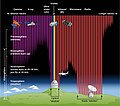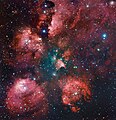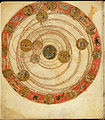|
The Astronomy Portal
Introduction Astronomy is a natural science that studies celestial objects and the phenomena that occur in the cosmos. It uses mathematics, physics, and chemistry in order to explain their origin and their overall evolution. Objects of interest include planets, moons, stars, nebulae, galaxies, meteoroids, asteroids, and comets. Relevant phenomena include supernova explosions, gamma ray bursts, quasars, blazars, pulsars, and cosmic microwave background radiation. More generally, astronomy studies everything that originates beyond Earth's atmosphere. Cosmology is a branch of astronomy that studies the universe as a whole. Astronomy is one of the oldest natural sciences. The early civilizations in recorded history made methodical observations of the night sky. These include the Egyptians, Babylonians, Greeks, Indians, Chinese, Maya, and many ancient indigenous peoples of the Americas. In the past, astronomy included disciplines as diverse as astrometry, celestial navigation, observational astronomy, and the making of calendars. Professional astronomy is split into observational and theoretical branches. Observational astronomy is focused on acquiring data from observations of astronomical objects. This data is then analyzed using basic principles of physics. Theoretical astronomy is oriented toward the development of computer or analytical models to describe astronomical objects and phenomena. These two fields complement each other. Theoretical astronomy seeks to explain observational results and observations are used to confirm theoretical results. Astronomy is one of the few sciences in which amateurs play an active role. This is especially true for the discovery and observation of transient events. Amateur astronomers have helped with many important discoveries, such as finding new comets. (Full article...) General images -The following are images from various astronomy-related articles on Wikipedia.
This is a Featured article, which represents some of the best content on English Wikipedia.
 The SAO/NASA Astrophysics Data System (ADS) is an online database of over 15 million records of publications developed by the National Aeronautics and Space Administration (NASA) on astronomy and physics. Abstracts are freely available for most articles, and fully scanned articles may be available in Graphics Interchange Format (GIF) and Portable Document Format (PDF). Hosted papers may be from peer reviewed or non-peer-reviewed sources. ADS is managed by the Smithsonian Astrophysical Observatory. Beginning in 1992, ADS is a research tool that improves astronomical research, and is specifically tailored to astronomical needs. The monetary benefit to astronomy that ADS contributes is equivalent to several hundred million in US dollars every year (2005). (Full article...)Did you know -
More Did you know (auto generated)
WikiProjectsSelected image - The International Space Station is photographed by an STS-134 crew member on the space shuttle Endeavour after the station and shuttle began their post-undocking relative separation. Undocking of the two spacecraft occurred on May 29, 2011. Astronomy News
April anniversaries
Astronomical eventsAll times UT unless otherwise specified.
TopicsSubcategoriesSelect [►] to view subcategories
Things you can do
WikibooksThese books may be in various stages of development. See also the related Science and Mathematics bookshelves.
WikijuniorAssociated WikimediaThe following Wikimedia Foundation sister projects provide more on this subject:
Discover Wikipedia using portals Shortcuts to this page: Astronomy portal • P:ASTRO Purge server cache |


























































